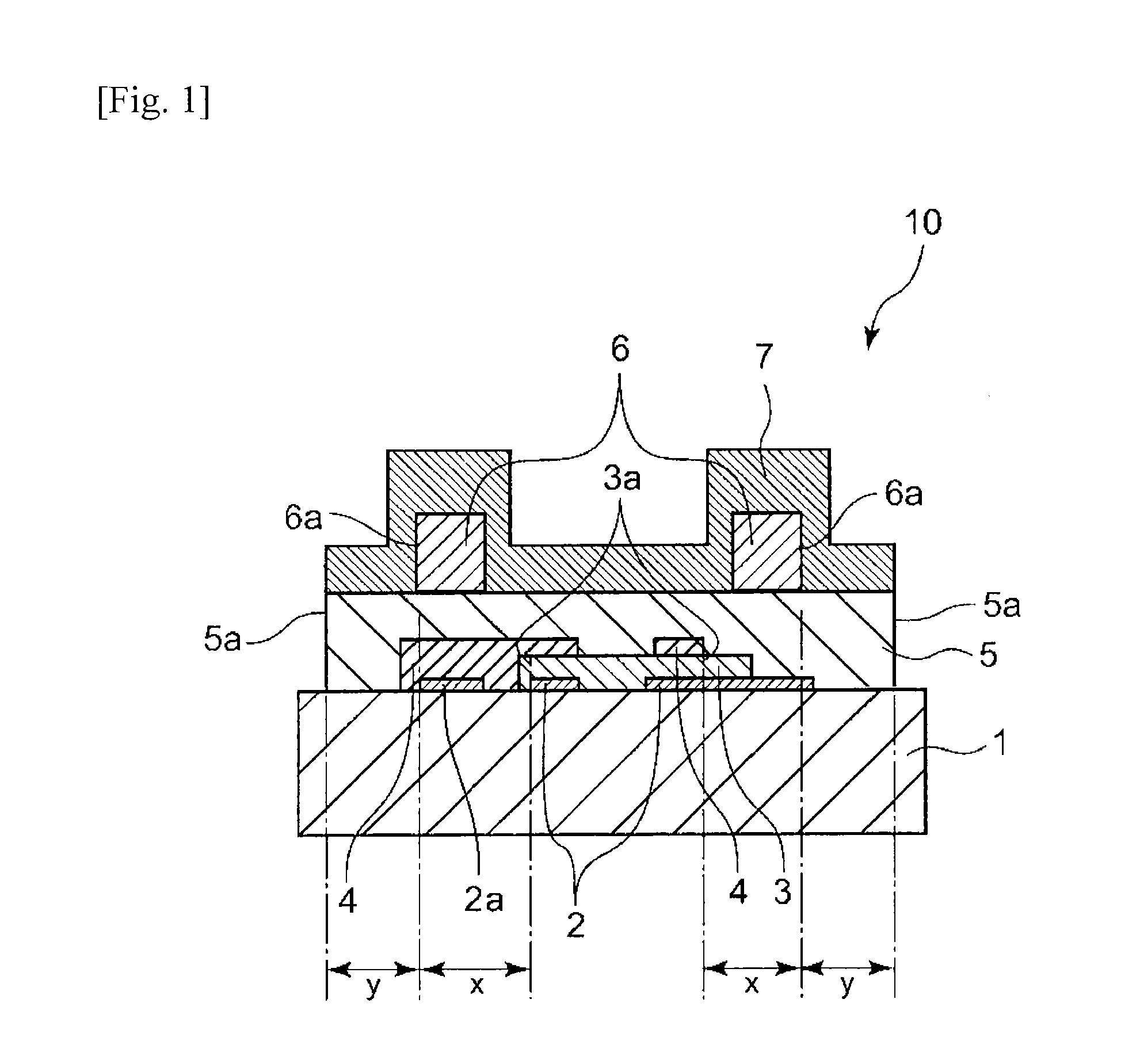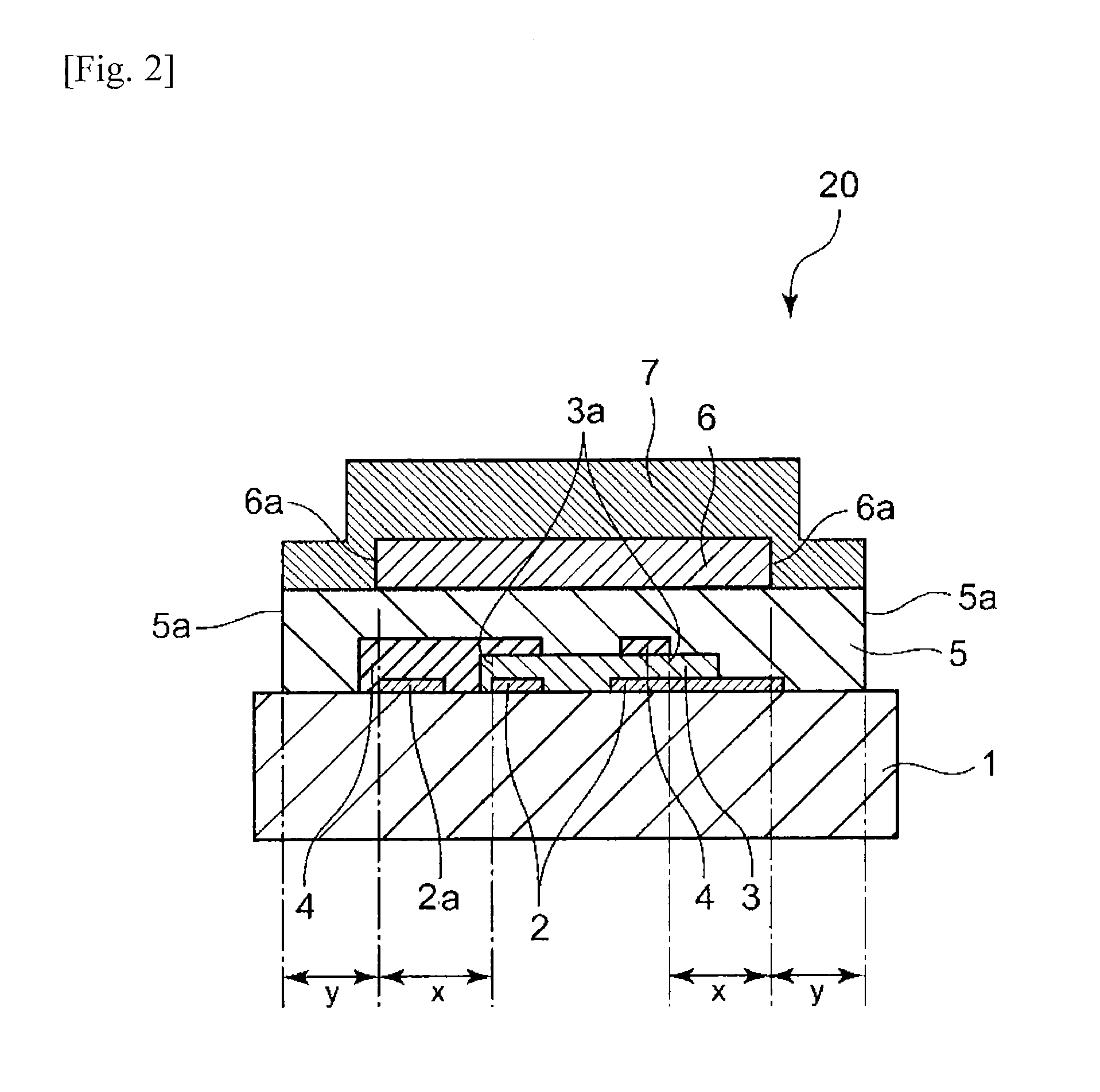Organic electroluminescence light-emitting device and production method thereof
- Summary
- Abstract
- Description
- Claims
- Application Information
AI Technical Summary
Benefits of technology
Problems solved by technology
Method used
Image
Examples
example 1
[0104]The organic EL light-emitting device shown in FIG. 1 was produced by the following method.
[0105]First, an organic electroluminescence element having a 2-mm-square luminescent region was produced in the manner shown in FIG. 3.
[0106]As an ITO substrate 1, use was made of a substrate constituted of a glass substrate 1 having a length of 3.75 cm, width of 2.5 cm, and thickness of 0.7 mm and, formed thereon, a transparent conductive film (anode 2) of indium-tin oxide (ITO) having a thickness of 70 nm.
[0107]Subsequently, a polymeric compound having the repeating structure represented by the following formula (6) (PB-1; weight-average molecular weight, 52,000; number-average molecular weight, 32,500) was mixed with 4-isopropyl-4′-methyldiphenyliodonium tetrakis(pentafluorophenyl)borate in a mass ratio of 100:20, and this mixture was dissolved in ethyl benzoate so as to result in a concentration of the mixture of 2.0% by weight, thereby preparing a composition. In the air, this compos...
example 2
[0119]The organic EL light-emitting device shown in FIG. 2 was produced by the following method.
[0120]First, an organic electroluminescence element having a 7-mm-square luminescent region was produced in the manner shown in FIG. 3. The method for producing the organic electroluminescence element is the same as in Example 1.
[0121]Next, a backing member was produced in the manner shown in FIG. 5.
[0122]An aluminum foil having a thickness of 100 μm was cut into a 100-mm square. DryPaste-S1 (manufactured by Saes Getters), which included calcium oxide as the main component, was used as a desiccant to form a hygroscopic layer having a square shape with a thickness of 50 μm and a side length of 18 mm on the cut aluminum foil in the air by means of a screen printing machine (HP-300, manufactured by Newlong Seimitsu Kogyo Co., Ltd.). Immediately after the printing, the aluminum foil was transferred to a nitrogen atmosphere and baked on a hot plate at 200° C. for 30 minutes. This aluminum foil...
example 3
[0125]The organic EL light-emitting device shown in FIG. 2 was obtained in the same manner as in Example 2, except that in place of the 50 μm-thick sheet-form pressure-sensitive adhesive which was a thermoplastic resin NE-1 sandwiched between two PET films, use was made of a 50 μm-thick sheet-form pressure-sensitive adhesive sandwiched between two PET films and constituted of a thermoplastic resin NE-2 obtained by mixing polyisobutylene, a cyclopentadiene / dicyclopentadiene copolymer, and polybutene in a mass ratio of 23:58:19.
PUM
 Login to View More
Login to View More Abstract
Description
Claims
Application Information
 Login to View More
Login to View More - R&D
- Intellectual Property
- Life Sciences
- Materials
- Tech Scout
- Unparalleled Data Quality
- Higher Quality Content
- 60% Fewer Hallucinations
Browse by: Latest US Patents, China's latest patents, Technical Efficacy Thesaurus, Application Domain, Technology Topic, Popular Technical Reports.
© 2025 PatSnap. All rights reserved.Legal|Privacy policy|Modern Slavery Act Transparency Statement|Sitemap|About US| Contact US: help@patsnap.com



